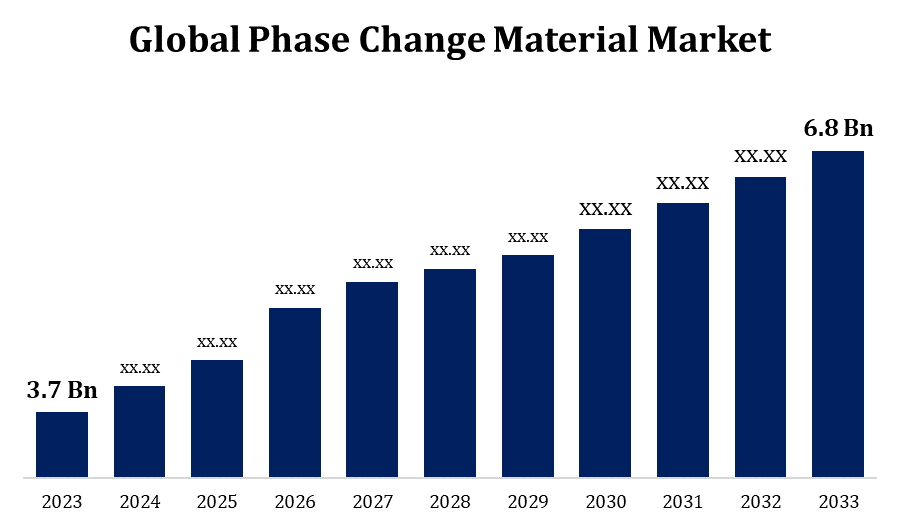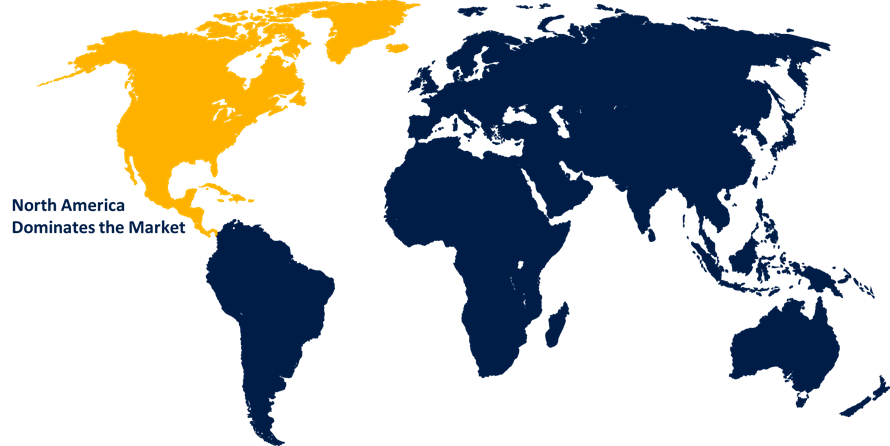Global Phase Change Material Market Size By Type (Organic, Inorganic, Eutectic), By Application (Building and Construction, Packaging, Textiles, Electronics, Transportation), By Region, And Segment Forecasts, By Geographic Scope And Forecast to 2033
Industry: Chemicals & MaterialsGlobal Phase Change Material Market Insights Forecasts to 2033
- The Phase Change Material Market Size was valued at USD 3.7 Billion in 2023.
- The Market Size is Growing at a CAGR of 6.27% from 2023 to 2033
- The Worldwide Phase Change Material Market Size is Expected to Reach USD 6.8 Billion by 2033
- Asia Pacific is Expected to Grow the fastest during the forecast period

Get more details on this report -
The Global Phase Change Material Market Size is Expected to Reach USD 6.8 Billion by 2033, at a CAGR of 6.27% during the forecast period 2023 to 2033.
Phase Change Material is utilised in building envelopes, walls, and roofs to adjust inside temperatures and reduce heating and cooling energy usage. Phase Change Material-infused materials are used to improve comfort by actively controlling body temperature in apparel, bedding, and sporting. The incorporation of Phase Change Material into building materials improves thermal mass, which stabilises indoor temperatures and reduces the demand for HVAC systems. Demand for Phase Change Material in construction is being driven by an increasing global emphasis on energy efficiency and demanding building requirements. Microencapsulation technological advancements improve the stability and performance of Phase Change Material in a variety of applications. Phase Change Material demand varies by region, with more adoption in areas with harsh climates where temperature regulation is critical. The initial expenditures of incorporating Phase Change Material can be a barrier to acceptance, although long-term energy savings may compensate.
Global Phase Change Material Market Report Coverage
| Report Coverage | Details |
|---|---|
| Base Year: | 2023 |
| Market Size in 2023: | USD 3.7 Billion |
| Forecast Period: | 2023 - 2033 |
| Forecast Period CAGR 2023 - 2033 : | 6.27% |
| 2033 Value Projection: | USD 6.8 Billion |
| Historical Data for: | 2019 - 2022 |
| No. of Pages: | 200 |
| Tables, Charts & Figures: | 110 |
| Segments covered: | By Type, By Application, By Region. |
| Companies covered:: | AI Technology Inc., Boyd Corporation, Climator Sweden AB, Cold Chain Technologies, Croda International PLC, Cryopak Industries Inc, Dupont De Nemours, Henkel Ag & Company KGaA, Honeywell Electronic Materials, Microtek Laboratories Inc., Phase Change Energy Solutions, Pluss Advanced Technologies, Puretemp LLC, Rubitherm Technologies GmbH, Sasol Limited, and Others |
| Growth Drivers: | Rising adoption of phase change material market in building industry |
| Pitfalls & Challenges: | COVID-19 Empact, Challenge, Future, Growth, & Analysis |
Get more details on this report -
Phase Change Material Market Value Chain Analysis
The synthesis of certain chemical compounds, such as fatty acids or esters, is required for the creation of organic Phase Change Materials. Extraction or synthesis of salts or metals may be required for inorganic Phase Change Materials. To make Phase Change Material products, raw materials are processed and formulated. This could include techniques like encapsulation, in which Phase Change Material is microencapsulated for increased stability and performance. To achieve the correct thermal characteristics and performance of the Phase Change Material, stringent quality control techniques are applied. Manufacturers, distributors, and specialised suppliers are among the avenues via which Phase Change Material products are distributed. Reaching out to companies and sectors where Phase Change Material can deliver energy-efficient solutions, such as building construction, textiles, electronics, and cold chain logistics, is part of the sales effort. Phase Change Material is used in building materials to regulate thermal energy and improve energy efficiency.
Phase Change Material Market Opportunity Analysis
The increased construction activity around the world provides a potential for Phase Change Material incorporation into building materials to improve energy efficiency and temperature regulation. The growing demand for sustainable building techniques and certifications presents an opportunity for Phase Change Material as a green building solution. The ability of Phase Change Material to store and release thermal energy corresponds to the expansion of renewable energy sources, particularly solar. By storing extra energy for later use, Phase Change Material can supplement solar energy systems. With the growth of the cold chain logistics business, Phase Change Material has an opportunity to play a critical role in maintaining appropriate temperatures during the storage and transit of temperature-sensitive items. With the increasing need for electronic products, there is a chance for Phase Change Material to be integrated into electronics for effective heat management, assuring optimal performance and lifetime.
Market Dynamics
Phase Change Material Market Dynamics
Rising adoption of phase change material market in building industry
Phase Change Materials are used in building materials to increase thermal mass, reduce temperature swings, and boost energy efficiency. This is especially useful in climate-sensitive areas. As they comply with standards emphasising energy efficiency and sustainability, Phase Change Materials help to achieve green building certifications like as LEED (Leadership in Energy and Environmental Design). The ability of Phase Change Material to store and release thermal energy reduces reliance on HVAC (Heating, Ventilation, and Air Conditioning) systems, resulting in energy and cost savings. By stabilising temperatures, lowering overheating, and reducing the demand for external heating or cooling, Phase Change Material integration improves indoor thermal comfort. The usage of Phase Change Material as an eco-friendly solution is being driven by rising environmental consciousness and demand for sustainable construction methods.
Restraints & Challenges
Integrating Phase Change Material into architectural materials or products may incur higher initial costs than standard alternatives. This can be a hurdle to adoption, particularly for organisations with limited resources. Phase Change Material must be compatible with various construction materials and systems, which can vary. It is difficult to provide seamless integration without jeopardising structural integrity. Architects, builders, and other industry stakeholders are not familiar with or comprehend Phase Change Material technology. To bridge this knowledge gap and promote wider use, education programmes are required. The lack of standardised testing methodologies and certifications for Phase Change Material equipment can create confusion regarding performance and make it difficult to set unambiguous standards. The number of providers offering varied Phase Change Material alternatives may be restricted, and the range of commercially accessible Phase Change Material products may be limited.
Forecasts
North America Market Statistics

Get more details on this report -
North America is anticipated to dominate the Phase Change Material Market from 2023 to 2033. In North America, the emphasis on energy efficiency in building design and construction creates a favourable atmosphere for Phase Change Material adoption. Phase Change Material is used in construction materials to increase thermal mass and control indoor temperatures. The globally recognised green building grading system, Leadership in Energy and Environmental Design (LEED), encourages the use of sustainable materials such as Phase Change Material in construction projects. North America is home to research institutions and innovation hubs that are actively working to advance Phase Change Material technology, investigate new formulations, and broaden its uses. Phase Change Material integration improves HVAC system efficiency by minimising the need for frequent temperature adjustments, which results in energy savings in commercial and residential buildings.
Asia Pacific Market Statistics
Asia Pacific is witnessing the fastest market growth between 2023 to 2033. The Asia-Pacific region is rapidly industrialising, fueling demand for energy-efficient and sustainable manufacturing methods. In industrial applications, Phase Change Material is utilised to improve thermal management. The Asia-Pacific construction sector is expanding rapidly as a result of urbanisation and infrastructural development. Phase Change Material is used in building materials to improve energy efficiency and reduce construction's environmental effect. The Asia-Pacific area is a manufacturing hotspot. Phase Change Material is used in the automobile sector for thermal management, which helps to improve vehicle energy efficiency. The region is abundant in agricultural resources, ensuring a consistent supply of natural fibres for use in biocomposite materials with Phase Change Material applications.
Segmentation Analysis
Insights by Type
The organic segment accounted for the largest market share over the forecast period 2023 to 2033. Organic Phase Change Materials are carbon-based molecules like fatty acids and esters. The usage of organic materials encourages eco-friendly alternatives and coincides with sustainability aims. Organic Phase Change Materials have a wide range of transition temperatures, allowing you to choose materials that meet specific temperature requirements in a variety of applications. This adaptability increases their utility in a variety of industries. Organic Phase Change Materials are used in construction materials to increase thermal mass and control indoor temperatures. This application adds to energy-efficient and environmentally friendly building techniques. Organic Phase Change Materials are being investigated for thermal management in electronics, with the goal of assisting in the effective cooling of electronic equipment and reducing overheating.
Insights by Application
The building and construction segment accounted for the largest market share over the forecast period 2023 to 2033. Phase Change Materials are incorporated into building materials to increase thermal mass, which aids in temperature regulation and decreases the need for external heating or cooling. Phase Change Material applications aid in the achievement of Leadership in Energy and Environmental Design (LEED) certification and other green building requirements that emphasise energy efficiency and sustainability. Phase Change Material integration contributes to the optimisation of HVAC systems by reducing the frequency and severity of temperature adjustments, resulting in energy savings. Phase Change Material is utilised in residential construction to improve energy efficiency in applications such as insulation and roofing. Phase Change Material is used in commercial buildings such as offices and retail spaces, helping to achieve sustainability goals.
Recent Market Developments
- In October 2022, researchers from Shanghai Polytechnic University have developed highly efficient phase change microcapsules for storing solar energy.
Competitive Landscape
Major players in the market
- AI Technology Inc.
- Boyd Corporation
- Climator Sweden AB
- Cold Chain Technologies
- Croda International PLC
- Cryopak Industries Inc
- Dupont De Nemours
- Henkel Ag & Company KGaA
- Honeywell Electronic Materials
- Microtek Laboratories Inc.
- Phase Change Energy Solutions
- Pluss Advanced Technologies
- Puretemp LLC
- Rubitherm Technologies GmbH
- Sasol Limited
Market Segmentation
This study forecasts revenue at global, regional, and country levels from 2023 to 2033.
Phase Change Material Market, Type Analysis
- Organic
- Inorganic
- Eutectic
Phase Change Material Market, Application Analysis
- Building and Construction
- Packaging
- Textiles
- Electronics
- Transportation
Phase Change Material Market, Regional Analysis
- North America
- US
- Canada
- Mexico
- Europe
- Germany
- Uk
- France
- Italy
- Spain
- Russia
- Rest of Europe
- Asia Pacific
- China
- Japan
- India
- South Korea
- Australia
- South America
- Brazil
- Argentina
- Colombia
- Middle East & Africa
- UAE
- Saudi Arabia
- South Africa
Frequently Asked Questions (FAQ)
-
1. What is the market size of the Phase Change Material Market?The global Phase Change Material Market is expected to grow from USD 3.7 Billion in 2023 to USD 6.8 Billion by 2033, at a CAGR of 6.27% during the forecast period 2023-2033.
-
2. Who are the key market players of the Phase Change Material Market?Some of the key market players of market are AI Technology Inc., Boyd Corporation, Climator Sweden AB, Cold Chain Technologies, Croda International PLC, Cryopak Industries Inc, Dupont De Nemours, Henkel Ag & Company KGaA, Honeywell Electronic Materials, Microtek Laboratories Inc., Phase Change Energy Solutions, Pluss Advanced Technologies, Puretemp LLC, Rubitherm Technologies GmbH, and Sasol Limited.
-
3. Which segment holds the largest market share?The building and construction segment holds the largest market share and is going to continue its dominance.
-
4. Which region is dominating the Phase Change Material Market?North America is dominating the Phase Change Material Market with the highest market share.
Need help to buy this report?